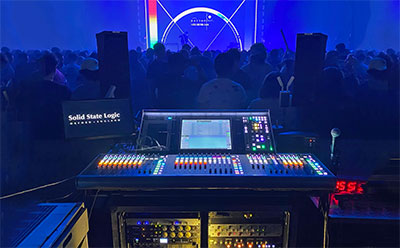A two-month US tour in late September promoting his sophomore album, Nurture, will take DJ/record producer/musician/singer Porter Robinson from coast to coast and back, Accompanying him at FOH with a Solid State Logic Live L200 mixing console is Simon Thomas, using a fully Dante-networked set-up that supports Robinson’s live vocal, keyboards and sample pad with playback tracks.
‘I’ve used SSL Live since 2014, when they started to come online,’ says Thomas, whose touring clients over the past decade include Halsey, Ariana Grande, Sara Bareilles, Sam Smith and Tori Kelly. ‘My view was that it sounded way better than anything else out there – and it still does.’
 On previous tours with the likes of Halsey, Thomas has typically used an SSL Live L550, for its processing capacity – but the L200’s configuration is better suited to the Nurture Live Tour: ‘I went for the L200 because I like the layout – it’s the best of the whole Live series – and there wasn’t any need for more processing power,’ he says. ‘With all the support acts, which include Jai Wolf and James Ivy, I’ve managed to fill up 96 paths on the console, including a significant number of talkback channels’.
On previous tours with the likes of Halsey, Thomas has typically used an SSL Live L550, for its processing capacity – but the L200’s configuration is better suited to the Nurture Live Tour: ‘I went for the L200 because I like the layout – it’s the best of the whole Live series – and there wasn’t any need for more processing power,’ he says. ‘With all the support acts, which include Jai Wolf and James Ivy, I’ve managed to fill up 96 paths on the console, including a significant number of talkback channels’.
On the Nurture tour, rather than transporting the stage inputs to FOH over Madi, which would be more typical, the whole show is built around a Dante infrastructure. ‘So we’re using SSL’s Network IO SB 32.24 Dante stageboxes, which is a little different,’ Thomas says. ‘We put SSL’s Blacklight II Bridge in the front-of-house rack with me, so we’ve only got a short optical link to the console. It means we only have to run Cat5 cables to front-of-house from the stage, which has worked well.’
‘There aren’t many tours doing Dante like we are, where everybody can see everybody else’s stage racks, and everybody can pick up what they want off the network,’ he continues. ‘What I really like is that it picks up the labelling of whatever is plugged into it. They just plug in, it pops up on my network, I drag-and-drop it in, and there it is, labelled. It’s patch and play.’
Although Thomas is using analogue outboard, he’s also making use of the Live console’s DSP. ‘I’ve been using the Blitzer on the bass stem,’ he reveals. ‘And the standard bus compressors are nice; they have a parallel function on them, so you can bring back in some of the original source. We’re also using some of the onboard reverbs. So we’re doing most of it onboard, which is cool.’
In addition to the L200’s onboard DSP, Thomas has an SSL Fusion processor: ‘Which is one of my old tricks – everybody says, “Oh, you’ve got the Fusion across the master bus”. No, it’s my vocal processor. I think the unit is amazing, one of the best vocal processing units I’ve ever come across. It does what you expect any SSL product to do – work and sound good.’
Thomas has previously used a Fusion on tour with Halsey: ‘I like it on vocal because you’ve got that Vintage Drive. With the Drive and the Density controls you can add all those extra harmonics that are very pleasing. Simply turning it on and inserting it, you get 3dB more gain out of your vocal, and that’s really useful. Our monitor engineer is also using a Fusion across the mix to the artist’s IEMs.’
As for the Violet EQ section of Fusion, he says, ‘It’s nice to have a bit of shelving EQ on your stems. It’s quick to grab if you’ve got too much high-end on something in front of the PA, or if you want to add a little bit to drive it into the HF compressor. I find that really useful.’
Thomas is essentially live-mastering a stem-based mix of the live channels and playback tracks coming out of Ableton and over Dante: ‘I’ve got playback stems that have been separated out into six stems – drums, bass, melodic stuff and backing vocals, plus the vocal stem and the onboard reverb and effects stem,’ he elaborates. ‘I’m making quite a lot of use of EQ from song to song, and every song has been built on a scene-by-scene basis. The songs go from one extreme to another, from typical EDM to what I call commercial EDM pop. So I’m doing a lot of mastering on this gig.’
Part of the idea behind the multi-stem configuration was that it provides feeds for any broadcast mix needs along the way. But so far on the tour, Thomas says, ‘They’ve been taking my left-right mix, because they like how it sounds. I input the shotgun mic and other condenser mics into the matrix and we can feed that to broadcast to vary the amount of crowd mics to add a bit of ambience into the mix.’
More: www.solidstatelogic.com